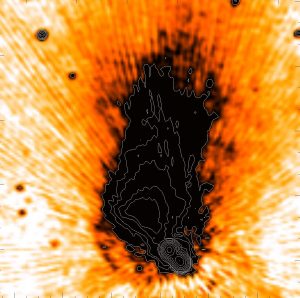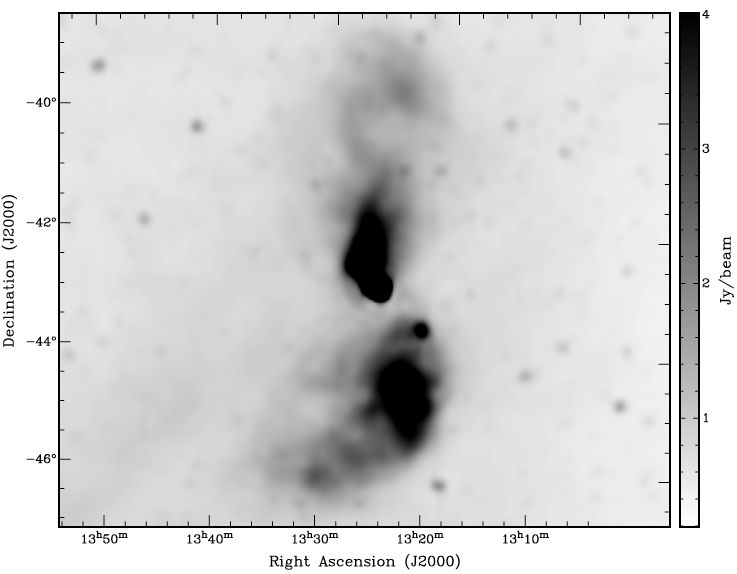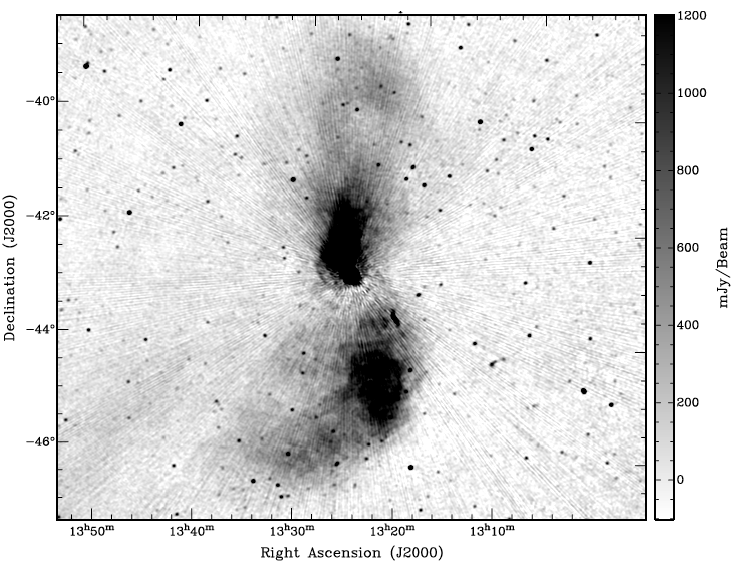Astronomers have used two Australian radio telescopes and several optical telescopes to study complex mechanisms that are fuelling jets of material blasting away from a black hole 55 million times more massive than the Sun.
In research published today, the international team of scientists used the telescopes to observe a nearby radio galaxy known as Centaurus A.

A close-up view of Centaurus A and the location of a black hole 55 million times more massive than the Sun. Credit: ICRAR/Curtin.
“As the closest radio galaxy to Earth, Centaurus A is the perfect ‘cosmic laboratory’ to study the physical processes responsible for moving material and energy away from the galaxy’s core,” said Dr Ben McKinley from the International Centre for Radio Astronomy Research (ICRAR) and Curtin University in Perth, Western Australia.
Centaurus A is 12 million light-years away from Earth—just down the road in astronomical terms—and is a popular target for amateur and professional astronomers in the Southern Hemisphere due to its size, elegant dust lanes, and prominent plumes of material.

The giant radio galaxy Centaurus A as observed by the Murchison Widefield Array telescope. Credit ICRAR/Curtin.
“Being so close to Earth and so big actually makes studying this galaxy a real challenge because most of the telescopes capable of resolving the detail we need for this type of work have fields of view that are smaller than the area of sky Centaurus A takes up,” said Dr McKinley.
“We used the Murchison Widefield Array (MWA) and Parkes—these radio telescopes both have large fields of view, allowing them to image a large portion of sky and see all of Centaurus A at once. The MWA also has superb sensitivity allowing the large-scale structure of Centaurus A to be imaged in great detail,” he said.
The MWA is a low frequency radio telescope located at the Murchison Radio-astronomy Observatory in Western Australia’s Mid West, operated by Curtin University on behalf of an international consortium. The Parkes Observatory is a 64-metre radio telescope commonly known as “the Dish” located in New South Wales and operated by CSIRO.
Observations from several optical telescopes were also used for this work— the Magellan Telescope in Chile, Terroux Observatory in Canberra, and High View Observatory in Auckland.

Centaurus A observed at 2307 MHz by the the Parkes radio telescope, as part of the S-PASS survey. Credit: E. Carretti and the S-PASS team.
“If we can figure out what’s going in Centaurus A, we can apply this knowledge to our theories and simulations for how galaxies evolve throughout the entire Universe,” said co-author Professor Steven Tingay from Curtin University and ICRAR.
“As well as the plasma that’s fuelling the large plumes of material the galaxy is famous for, we found evidence of a galactic wind that’s never been seen—this is basically a high speed stream of particles moving away from the galaxy’s core, taking energy and material with it as it impacts the surrounding environment,” he said.
By comparing the radio and optical observations of the galaxy the team also found evidence that stars belonging to Centaurus A existed further out than previously thought and were possibly being affected by the winds and jets emanating from the galaxy.
Publication Details
‘The jet/wind outflow in Centaurus A: a local laboratory for AGN feedback’, published in the Monthly Notices of the Royal Astronomical Society on December 12th, 2017.
Research paper available from here.
MORE INFORMATION
The MWA
The Murchison Widefield Array (MWA) is a low frequency radio telescope and is the first of four Square Kilometre Array (SKA) precursors to be completed.
A consortium of partner institutions from seven countries (Australia, USA, India, New Zealand, Canada, Japan, and China) financed the development, construction, commissioning, and operations of the facility. The MWA consortium is led by Curtin University.
Parkes Observatory
Parkes Observatory, just outside the central-west NSW town of Parkes, hosts the 64-metre Parkes radio telescope, one of the telescopes comprising CSIRO’s Australia Telescope National Facility.
ICRAR
The International Centre for Radio Astronomy Research (ICRAR) is a joint venture between Curtin University and The University of Western Australia with support and funding from the State Government of Western Australia.
CASS
CSIRO Astronomy and Space Science (CASS) operates the Australia Telescope National Facility (ATNF), comprising a set of world-class radio-astronomy observatories including the Parkes 64-metre radio telescope and the Australia Telescope Compact Array (ATCA) in New South Wales, and the Australian Square Kilometre Array Pathfinder (ASKAP) in Western Australia.
CONTACT INFORMATION
Dr Ben McKinley (ICRAR / Curtin University / CAASTRO)
Ph: +61 424 871 986 E: Ben.Mckinley@icrar.org
Professor Steven Tingay (ICRAR / Curtin University)
Ph: +61 401 103 635 E: Steven.Tingay@icrar.org
Pete Wheeler (Media Contact, ICRAR)
Ph: +61 423 982 018 E: Pete.Wheeler@icrar.org


